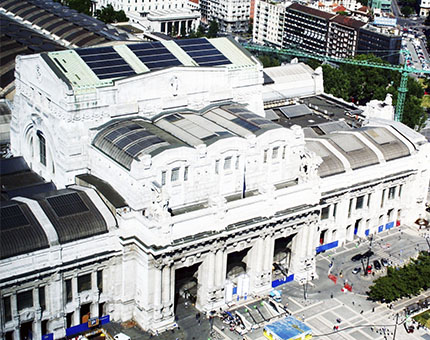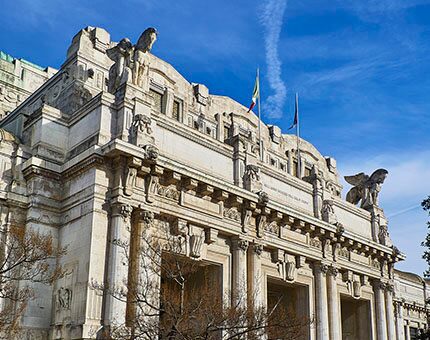Centrale neighbourhood
It would be impossible to imagine the Centrale neighbourhood without the majestic station that lends it its name. The Stazione di Milano Centrale is much more than just another station on the Italian rail network. You only need to take one look at its magnificent 200-metre-wide façade, clearly inspired by the Union Station in Washington, to realise that this is one of Europe’s most impressive railway terminals. If you didn’t arrive in Milan by train, it is well worth heading to the station to check out its stunning architecture.
This effect —having a profound impact on the traveller, regardless of whether they were arriving in or leaving the city— was no accident. On the contrary, Benito Mussolini wanted to associate the monumental character of the station with the strength of his fascist regime. During his mandate, the initial project for a new station to replace the old Centrale Station of Milan —which, at the beginning of the 20th century, was becoming too small to cope with the increase in rail traffic— was modified considerably to achieve this goal.
Mussolini was aware that train stations (a space of passage or “non-place”, as defined by the French anthropologist Marc Augé) were, and remain, particularly effective places for leaving an impression on travellers. In many cases, they are the first thing people see in a city; in some cases, they are the only thing.
Leaving its history to one side, we recommend visiting its large hall and admiring the monumental steel and glass vaulted ceiling that shelters its twenty-four platforms. Amidst the flurry of arriving travellers and emotional farewells, you’ll see that the Stazione di Milano Centrale has a personality of its own, standing as a city in its own right that serves as a communications hub for the Lombardy capital. And if you happen to need any more reasons to visit, book lovers should know that it is home to the largest bookshop in the country: La Feltrinelli Express.
The Pirelli Tower stands at the other end of the Piazza Duca d’Aosta: a colossal skyscraper that is now home to the headquarters of the Lombardy Regional Council and was once one of the tallest buildings in Europe. The tower was built between 1956 and 1960 by Gio Ponti, a multi-faceted architect who declared himself a great lover of his city of birth and who was largely responsible for it becoming an international design hub. From the top floor of the tower, you can enjoy one of the best views of the city’s skyline, in which the formidable Brutalist Velasca Tower stands out.
Finally, just a short distance from Milano Centrale is the Corso Buenos Aires: a long avenue connecting Porta Venezia to Piazzole Loreto. This is the perfect place to go shopping and bargain hunting, as it has 1,600 metres of clothing, footwear and accessory outlets.
Nearby plans
Related plans

Milan Central Station: majestic and impressive
Milan Central Station is the second most important station in Italy and one of the largest in Europe.

Shopping in Milan — discover the best places to go shopping
Milan is undoubtedly one of the world’s great shopping cities. Anyone who enjoys shopping has every reason to visit this Italian city

Milan with children: things to do for the whole family
To enjoy Milan with children all you need to do is plan activities for the whole family, combining visits to different places with boat trips, parks and themed museums.


